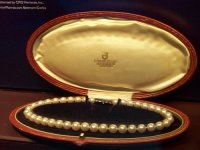Hello Skoozer,
Welcome! Can you please answer 1 4 and 5? Your photos are useful, although I can't see the clasp clearly.
1. Do the pearls feel slightly gritty or smooth when rubbed gently against your tooth or against another pearl?
If they are gritty, they are likely to be real nacre (genuine pearls.) If they feel smooth, they are likely imitation pearls.
2. Please provide clear, in-focus photos without flash against a white background (a paper towel works nicely.)
Include close-ups of the clasp (front and back) and a few of the pearls. If there are flaws, include a photo of those. Also the box they came in, and tags if you have them.
3. Any history you can give us about the pearls. Where/when you or your relative got them, any documentation you have (receipts, appraisals), their price range if you know it, etc.
4. Describe any marks on the clasp. These may be numbers (14K, 585, 750, 925 etc.) or brand names or even pictures.
5. Measure the pearls, with a millimeter ruler if possible. If they are graduated, measure the largest and smallest pearls.
It's possible these are natural color blue silver cultured akoya pearls. A friend showed me her drop shape pearl pendant from that era 6 months ago. It was intensely blue with pink overtones. I had never seen an akoya pearl so beautiful. These pearls seem similar in color to her pendant.
In the last few years we are seeing natural color akoya in blue-silver, pale pink, light gold and even pale green.
That said, akoyas have been dyed black (peacock) and silver for many years. Whether this is a dyed color or natural color will make a difference in the value.
Let's see what others have to say~






